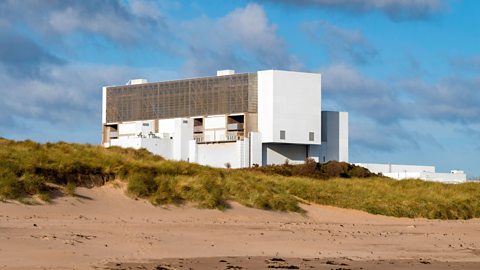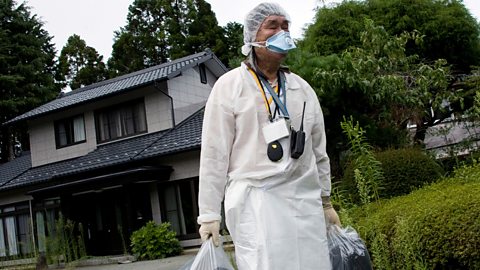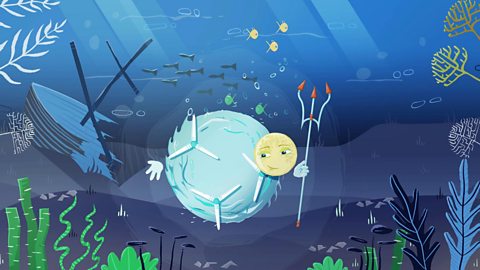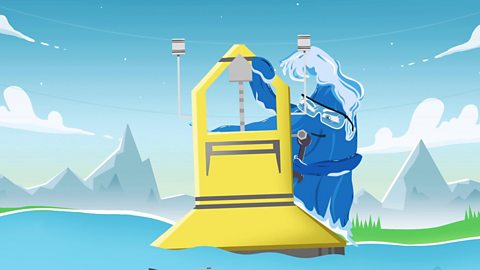Introduction to nuclear energy
Nuclear energy from inside atoms can be used to generate huge amounts of electricity.
In this article you can learn about:
- Where nuclear energy comes from
- What happens inside a nuclear power station
- What nuclear radiation is
- What the advantage and disadvantages of nuclear energy are
This resource is suitable for energy and sustainability topics for primary school learners.
Video - Nuclear energy
Introducing Nuclear power. You’ve got to be careful around him.
And not just because of the harmful radiation he gives out. You see, he's a bit sensitive… oh!
He's split in two… He’s always doing that.
To understand why, you’ve got to think about what we’re all made from – atoms.
Every atom contains a lot of energy.
And there are certain kinds of atom - like this stuff, uranium - which are unstable and can split.
When they do, they release radiation and heat. The radiation is a problem because it can make people ill.
The heat though – well that’s really useful.
This is Torness nuclear power station in East Lothian.
Like most nuclear power stations, it uses rods made from uranium.
A uranium atom splits when a neutron hits it. The split atom then fires out more neutrons that split even more atoms.
This is called a chain reaction.
All these splitting atoms release a lot of energy, making the uranium rods very, very hot. This heat turns water into steam which spins turbines connected to generators, which convert all that kinetic energy into electricity.
There's a lot of heat… but nothing’s burning! So, there's no air pollution.
Is Nuclear power renewable, then? Hmmm… afraid not – uranium is mined from the earth. So one day we'll run out.
He works hard though. Renewable energies like wind and solar only go to work when the weather's right, but Nuclear power never stops, not even for a cup of tea!
But the harder he works, the more radiation he puts out.
To contain it, nuclear power stations have to be very solid, which is expensive.
And eventually, the uranium reaction fizzles out, leaving nuclear waste – which is really hard to get rid of.
It stays toxic for millions of years!
So, Nuclear power really is difficult to deal with.
Oh no, that’s upset him… he’s getting out of control!!
What? What did I say…?
What is nuclear energy?
Everything in the universe is made out of atomTiny particles that everything in the universe is made from. Different atoms make up different materials, called elements.. At the centre of each atom is a nucleusThe centre of an atom. The nucleus is made up of smaller particles called protons and neutrons. and this is held together by lots of energy.
We call this nuclear energy.
How can we use nuclear energy?
Some materials, like uranium, are unstable. This means that their atoms are easier to break apart.
Uranium rods are used as fuelA source of energy. in a nuclear power station.
A tiny particle called a neutron is fired at the uranium. This splits one of the uranium atoms apart.
The atom splits into smaller atoms and fires out more neutrons. These neutrons hit other atoms and split them apart. So every time an atom splits it causes more atoms to split. This is called a chain reaction.
All the splitting atoms release energy in the form of heat. The heat is used to turn water into steam.
The moving steam is used to turn turbineA turbine is a machine that turns the movement of liquid or gas into energy that can be used. In a simple turbine water or air push against turbine blades and spin them round. The spinning blades turn a long pole called a shaft. The shaft can then turn other pieces of machinery, such as a generator that is used to produce electricity.. These turn generatorA machine that is used to make electricity. When the generator head is turned, this energy is converted to electrical energy. that make electricity.

Dangers of nuclear power

Splitting uranium atoms releases nuclear radiationEnergy and particles given out when the nucleus of an atom splits apart. .
Nuclear radiation is all around us. It reaches us from space, rocks, plants and animals. We even give out radiation ourselves.
Large amounts of nuclear radiation can be very dangerous to all living things, including people. In the past, accidents at nuclear power stations have had big problems.
In 1986 in Ukraine, a power failure at the Chernobyl nuclear power plant meant the chain reaction went out of control, causing explosions.
In 2011 an earthquakeA sudden shaking of the ground caused by different parts of the Earth's crust suddenly moving. and tsunamiA giant sea wave caused by an underwater earthquake, volcanic eruption or a landslide into the sea. caused explosions and unsafe nuclear reactions at the Fukushima nuclear power plant in Japan.
In both of these cases, a lot of radiation leaked into the outside world and was harmful to the people living and working around them. Radiation from Chernobyl was spread over thousands of miles - even reaching Scotland.

Nuclear waste

As well as producing electricity, nuclear power stations produce radioactive nuclear waste. This is dangerous for humans and harmful to the environment, animals, water supplies and plants. Some nuclear waste is so harmful that it is buried deep underground in specially sealed stores.
How nuclear waste is looked after is important because it can remain harmful for thousands of years.

The advantages and disadvantages of nuclear energy
Advantages of nuclear energy
Nuclear energy provides electricity without releasing greenhouse gases or air pollution.
Nuclear energy is reliable and produces electricity no matter the time of the day or the weather conditions.
Nuclear power stations produce cheap electricity once they are running.
Disadvantages of nuclear energy
Nuclear energy is not a renewable energy type. Uranium is mined from underground and it will run out.
The radiation produced by uranium is harmful and nuclear reactions need to be carefully controlled, so building nuclear power stations is very expensive.
The nuclear waste that uranium produces is toxic and remains harmful for thousands of years.

Key words about nuclear energy
Sorry, something went wrongCheck your connection, refresh the page and try again. – Tiny particles that everything in the universe, including you, is made from. Different atoms make up different materials, called elements.
Sorry, something went wrongCheck your connection, refresh the page and try again. – A chemical element that is used as fuel in nuclear power stations.
Sorry, something went wrongCheck your connection, refresh the page and try again. – Energy and particles given out when the nucleus of an atom splits apart.
Sorry, something went wrongCheck your connection, refresh the page and try again. – A type of power station that generates electricity using heat from nuclear reactions.
Sorry, something went wrongCheck your connection, refresh the page and try again. – A turbine has a shaft and blades that turn movement in to energy. Steam will push the blades and turn the shaft, connected to the generator. The generator head will turn to produce electricity.
Sorry, something went wrongCheck your connection, refresh the page and try again. – A machine that is used to make electricity. When the generator head is turned, this energy is converted to electrical energy.
Sorry, something went wrongCheck your connection, refresh the page and try again. – The waste material created by the process of generating nuclear power. Some nuclear waste is very radioactive and needs to be stored and disposed of very carefully.
Test your knowledge
Quiz
Challenge

Create a leaflet
Imagine a new nuclear power station is being built in your local area.
Would you be for or against this? Create a leaflet to argue your point and convince other people to agree with you. Consider issues around the advantages and disadvantages, plus the effects on your local area.
Here are some top tips for designing a leaflet: How to create a leaflet
More on Sustainability
Find out more by working through a topic
- count21 of 28

- count22 of 28

- count23 of 28

- count24 of 28
